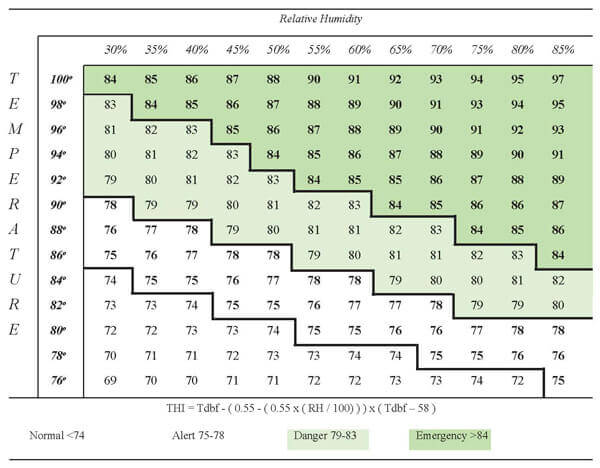Lush forages decrease livestock water needs. Dry forages increase livestock water needs.
Hay and dry feed contains only 10-12% moisture compared to 75%-80% moisture in lush forages. Animals need water to digest and move dry, fibrous feed through their gut.
Access to cool, clean drinking water is essential to keep an animal's internal body temperature within normal limits. As water temperature increases from 70 degrees F to 95 degrees F, total water requirements for each animal will increase by about 2.5 times.
It is thought that water temperature affects rumen temperature and thus blood temperature which affects brain centers that control feed consumption.
Increased water consumption will increase excretion of urine. This will also increase the loss of certain minerals, such as sodium, potassium, and magnesium.
Reference: Water, Heat Stress, & Drought, powerpoint presentation, by Barbara Bellows, NCAT Agriculture Specialist,ATTRA; Heat Stress & Beef Cattle, Boyles, Ohio State University, https://agnr.osu.edu/sites/agnr/files/imce/pdfs/Beef/HeatStressBeefCattle.pdf
Salts
Dangerous levels of salt content in livestock water
|
Livestock
|
Total Dissolved Solids
|
|
Cattle
|
3,000 ppm
|
|
Sheep
|
7,000 ppm |
Water quality often declines in stock ponds where soil has been deposited by runoff. Salt concentrations increase as water evaporates and water inflows decline during drought. Where stock ponds are the only water source, pastures should be grazed early in the season before extensive evaporation. Livestock water requirements will also be lower early in the season, when cool temperatures occur.
When water quality is poor, most livestock reduce their water intake which reduces performance. When animals become thirsty enough, they will eventually drink a large quantity of salty water. These animals may die rapidly (see table). This situation may become even more dangerous if livestock are forced to eat drought stricken forages with a high salt content, such as saltgrass or greasewood. (how to test for water quality)
Blue-green Algae
Under certain conditions pond water may develop lethal concentrations of blue-green algae. Algae multiplies rapidly under hot and dry weather conditions. Winds accumulate the algae along downwind shorelines on the surface of water. Under drought conditions water quality can change from non-toxic to toxic in several hours. Livestock that drink can die before traveling a few hundred yards or may suffer for a day before death. Animals that recover may slough white hide. Determining the cause of death is difficult because changes in weather can eliminate the problem and positive identification of blue-green algae requires microscopic examination. (how to test for blue-green algae)
Heat Stress
Drought is often associated with higher than average temperatures. In semi-arid regions on range, heat stress may only become an issue under conditions of extreme heat.

Source: UNL IANR NebGuide G1409
Have ample water available.
When temperatures reach 80 degrees, cattle need two to three gallons of water per 100 pounds of body weight. Put out extra watering tanks if needed. As well as lifesaving, having ample linear space for cattle to drink and stay cool can be important in maintaining cattle. Add additional water tank space until cattle have access to at least five gallons per hour and best if ten gallons per hour. Keeping waterers clean should encourage water consumption. Weekly scheduled waterer cleaning also improves the likelihood of finding malfunctioning waterers.
Avoid handling cattle if possible.
If cattle must be handled, work them from midnight to 8AM. Do not work cattle after 10AM. While it may seem to make sense to work cattle after sun down, wait until the cattle have had at least six hour of night cooling before working. This optimizes the calf’s innate diurnal rhythms in regard to heat accumulation and dissipation allowing the calf to deal more effectively with heat stress during the day. Work with the packers to schedule shipping cattle at night. Try to start loading after 1AM such that all cattle can arrive before 7AM. All packers have sprinklers and can keep the cattle comfortable. If cattle arrive with body temperature elevated above what would normally be expected carcass defects such as dark cutters may be more common.
Assess water supply and delivery capacity.
At the peak of the day the system needs to deliver 1.1% of body weight per hour. This can be calculated from line diameter and line pressure. These calculations should always be preformed before installing new watering systems. Check the flow rates on automatic water tanks in existing facilities to insure they can provide enough water for all the cattle in the pen in at least one hour. The gallons per minute a waterer can deliver can be estimated by using a rubber tube to divert from the waterer-input orifice (controlled by the float) into a bucket. Divert the water for 15 seconds and estimate the gallons that would have been delivered per minute. If deficiencies are identified in total supply or delivery at peak demand periods, additional supply and/or waterers must be added when temperatures are in the critical range. OR, the cattle should be spread out to more pens so that the existing water supply can better serve the critical needs of the cattle.
Move cattle away from wind breaks.
Wind breaks maybe great in the winter; they can be deadly in the summer. Identify wind dead spots in the feedlot and give these areas special attention. If possible, you may consider abandoning these pens during critical heat stress.